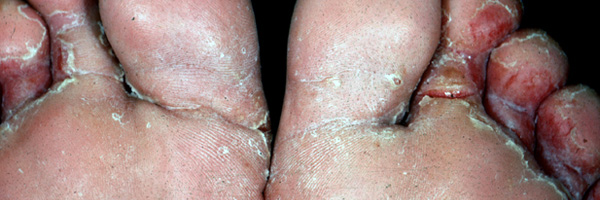Wie schützt man sich vor Fusspilz?
How to Prevent Athlete's Foot

Von / By Felix Gmünder
Diese Facts vorweg:
- Fusspilz ist eine ansteckende Infektionskrankheit mit speziellen Pilzen (Pilze sind weder Tiere noch Pflanzen).
- Jeder 5. Mensch leidet an einem Hautpilz. Fusspilze gehören zu den häufigsten Hautinfektionen. Nicht alle Menschen sind gleich empfindlich, manche haben dauernd Scherereien - andere, obwohl sie nie etwas tun, haben nie Probleme.
- Fusspilze kommen überall auf feuchten und von Menschen begangenen Fussböden vor (Duschen, Schwimmbäder, Wellnesszonen)
- Fusspilze wachsen am Besten in einem warmen, feuchten Klima (z.B. in engen Schuhen zwischen den Zehen!)
- Die in den Bädern vorhandenen Fussduschen zur "Desinfektion"
sind für die Katz:
- Das Desinfektionsmittel ist so mild, dass man die Füsse mindestens 5 bis 10 Minuten darin baden müsste.
- Die Fusspilze kommen überall vor: Auf den Böden (auch zu Hause), in den Socken etc.
- Wenn man im Bad Fusspilze aufliest, dann ganz sicher beim Gang zur und von der Fussdusche: Es gehen wahrscheinlich alle mit einem Jucken zwischen den Zehen dorthin.
First: Some Facts
- Athlete's Foot Athlete's Foot is an infectious disease caused by a fungus (tinea pedis). Fungi form their own kingdom of life, like plants and animals.
- 20% of the population suffers from fungi called dermatophytes like athlete's foot, which is the most widely spread skin disease. Not everybody is sensitive to these dermatophytes. Some people are predisposed and always have to worry about contracting it, others, although they never take care, never contract it.
- The fungi causing athlete's foot are abundant and thrive on moist and humid floors such as in showers, swimming pools, and spas.
- The fungi flourish best in warmth and humidity - and where do you find this? Maybe between your toes in narrow shoes!
- In some spas and pools in Europe spray systems are available with
a liquid that is supposed to disinfect your feet. Forget it!
- This disinfectant is so mild, that you would have to bathe your feet in it for at least 5 to 10 minutes to have an effect.
- The fungi persist everywhere: On floors (even at home), in socks etc.
- The best way to contract athlete's foot is where those having it already pass: Certainly on the way to and from the spray systems.
- Nie barfuss gehen, sondern mit Badeschlappen. Voraussetzung ist allerdings, die Badeschlappen wirklich immer, auch in der Sauna und unter der Dusche und bis an den Bassinrand zu tragen.
- Zehenzwischenräume vor dem Anziehen der Socken mit einem trockenen Tuch (Papier oder Stoff) gut abtupfen, ohne zu rubbeln - Rubbeln oder Reiben würden die Haut verletzen und empfindlicher für Infektionen machen. Diese Massnahme reicht in einfachen Fällen auch bei Befall zur spontanen Heilung und ist die beste Vorbeugemassnahme!
- Nach Möglichkeit keine engen Schuhe tragen - im Sommer lockeres Schuhwerk. Schuhe täglich austauschen und täglich gewaschene Socken tragen. Socken aus Wolle oder Baumwolle tragen und sie heiss waschen (60 Grad Wäsche).
- Hilft auch das nichts (zur spontanen Heilung) muss man zu speziellen Fusspilz-Mitteln greifen (in der Apotheke erhältlich).
- Nützt auch das nichts hilft nur der Gang zum Hautarzt.
- Don't walk barefooted in showers, swimming pools, and spas: wear sandals. But keep them on all the way from the changing room to the shower, sauna, or the deck.
- Dry the space between your toes carefully using a soft towel (or kleenex) before getting the socks on. Don't scrub the skin too hard, you might damage the top of it and pathe the way for the fungi. These two simple measures are sufficient in most cases to prevent infection and may even foster spontaneous healing.
- Don't wear narrow shoes - wear shoes that can "breathe". Rotate shoes on a daily basis and change socks every day. Use socks made of wool, cotton or any other natural fibre and wash them at 60 °C (140 °F).
- If these measures don't help you might try medication that stops dermatophytes (ointments, lotions etc. available in drug stores).
- If that does not help, please consult a doctor.